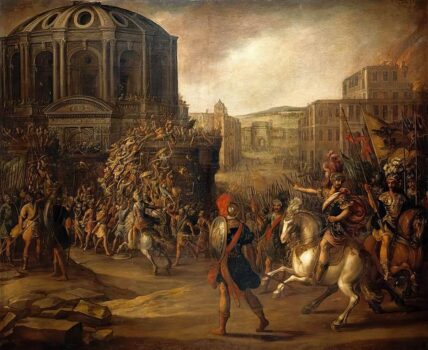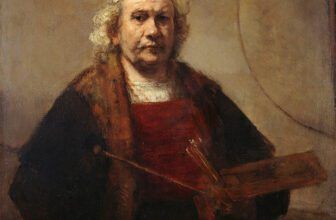The Story and Meaning of Battle Scene with a Roman Army Besieging a Large City
Art has long been one of humanity’s most powerful methods of storytelling, preserving narratives that reach beyond words into the realms of memory, history, and imagination. Among the painters of the Spanish Golden Age, Juan de la Corte (c. 1590–1663) carved out a unique role for himself as a chronicler of both religious and historical subjects. His works, often commissioned for royal collections and aristocratic patrons, frequently explored themes of grandeur, conquest, and devotion.
One particularly striking painting attributed to de la Corte is Battle Scene with a Roman Army Besieging a Large City. The work immerses the viewer in a dramatic tableau of military spectacle: legions of Roman soldiers storming the walls of a fortified city, the chaos of battle interwoven with architectural details, banners, and the suggestion of both triumph and tragedy. This painting is not simply a representation of war; it is a theatrical staging of history, myth, and allegory, bringing forth layers of meaning about power, empire, and human struggle.
In todays topic, we will explore the story behind this painting, the circumstances of its creation, its symbolism, and its meaning. We will analyze what is happening in the scene, what type of art it represents, and where the painting is located today. Through this lens, we can better understand how Juan de la Corte captured not only a moment of Roman warfare but also an enduring meditation on history and human ambition.
Before analyzing the painting itself, it is important to situate its creator. Juan de la Corte was born in Flanders, but his career flourished in Spain. He was active in Madrid during the reigns of Philip III and Philip IV, at a time when Spain was a global empire and art was both an expression of power and a reflection of its complexities.
De la Corte specialized in large historical compositions, pageantry, and architectural settings. He painted festivals, triumphal processions, and dramatic battles. His works were often narrative in nature, created to impress both visually and intellectually. His style blended the Flemish love of detail with the grandeur of Spanish courtly taste, resulting in paintings that were vibrant, theatrical, and deeply symbolic.
The Story of Battle Scene with a Roman Army Besieging a Large City
The painting depicts a dramatic siege: a Roman army surrounding and attacking a vast walled city. The scene bursts with energy and tension. Soldiers carry shields and spears, siege engines approach the walls, and flames and smoke rise as the defenders struggle to repel the assault. The city itself looms large in the background, its walls, towers, and gates serving as both a target and a symbol of resistance.
But what is the specific story? Juan de la Corte, like many artists of his time, often painted Roman or biblical battles less as historical reconstructions than as allegories of universal struggle. While the title suggests a generic Roman siege, the subject likely alludes to one of the great sieges of antiquity, such as:
The Roman conquest of Jerusalem in 70 CE under Titus.
The siege of Carthage during the Punic Wars.
The storming of Masada or other strongholds of resistance against Rome.
Each of these episodes carried symbolic weight in the early modern imagination. To a 17th-century Spanish audience, Rome represented both a model of empire and a cautionary tale. By staging the Romans’ conquest of a mighty city, de la Corte invited viewers to reflect on power, destiny, and the fragile balance between conquerors and the conquered.
What the Painting Represents
The Battle Scene with a Roman Army Besieging a Large City is about the clash between order and chaos, civilization and resistance, empire and defiance. The Roman army, disciplined and numerous, represents authority, structure, and inevitability. The besieged city, with its walls and defenders, embodies human determination, identity, and the desperate struggle to preserve independence.
For de la Corte’s patrons and audience, the painting was more than a historical vignette. It was a mirror to their own time. Spain in the 17th century was engaged in constant warfare , in Italy, the Low Countries, and the New World. The Roman conquest, then, was not distant history but a timeless parable of ambition and loss.
The work also reflects the Baroque fascination with spectacle. The violence of war becomes a stage where human passions , courage, fear, loyalty, betrayal , are magnified. The viewer is not invited to take sides so much as to witness the sheer scale of human endeavor and suffering.
Battle Scene with a Roman Army Symbolism and Meaning
De la Corte’s painting is full of layered symbolism:
The Roman Army
The legions stand for discipline, imperial destiny, and the machinery of power. In early modern Spain, Rome was often seen as a prototype for the Spanish Empire , a reminder of both its glory and its eventual decline.The Besieged City
The city symbolizes human pride, culture, and the desire to resist subjugation. Walled cities in Baroque art often stood for civilization under threat, for the precarious balance between protection and vulnerability.Fire and Smoke
Flames rising from the city evoke both destruction and purification. In allegorical terms, fire is the agent of transformation, reducing the old order to ashes so that a new order can arise.Siege Engines and Scaling Ladders
These are not merely tools of war but metaphors for human ingenuity and ambition. They embody the unstoppable force of technology and discipline against the fragile defenses of tradition.The Sky and Landscape
In many battle paintings of the period, the sky mirrors the drama of the earth. Clouds, storms, or rays of light suggest divine approval, wrath, or indifference. De la Corte likely used the heavens as a symbolic backdrop to the human spectacle below.
Together, these elements make the painting more than a scene of violence. It becomes a meditation on empire, destiny, and the cyclical nature of history.
What Is Happening in the Battle Scene with a Roman Army Painting?
A closer reading of the composition reveals multiple layers of action.
Foreground: Roman soldiers advance, shields raised, spears thrust forward. Some carry ladders to scale the walls, while others push siege towers. The intensity of their movement conveys the relentless pressure of a disciplined army.
Middle ground: The city walls are under assault. Defenders hurl stones, pour boiling substances, and try desperately to repel the invaders. Smoke rises, signaling that parts of the city are already burning.
Background: The city itself stretches out with towers, domes, and defensive structures. It looms like a monument, a prize that justifies the cost of bloodshed.
This layering of action creates a sense of depth and scale, pulling the viewer into the unfolding drama. The painting does not capture a single moment but rather condenses the entire narrative of a siege , preparation, assault, destruction, and inevitable conquest.
Battle Scene with a Roman Army Besieging a Large City is best understood as a work of Baroque historical painting. The Baroque period, spanning the 17th century, was characterized by drama, grandeur, and movement. Painters sought to overwhelm the senses and engage the viewer emotionally.
De la Corte’s battle scene belongs to the tradition of history painting, the most prestigious genre in the hierarchy of art. History painting encompassed biblical, mythological, and historical narratives, often on a grand scale. It required mastery of anatomy, architecture, perspective, and symbolism.
Within this genre, battle scenes formed a distinct subcategory. They combined topographical accuracy with theatrical imagination, serving both as records of military might and as moral lessons. De la Corte, like his contemporaries, emphasized spectacle over literal accuracy, crafting a scene that was as much allegory as history.
The Location of the Battle Scene with a Roman Army Painting Today
Battle Scene with a Roman Army Besieging a Large City is part of the collection of the Prado Museum in Madrid, Spain. The Museo del Prado houses many of Juan de la Corte’s works, as well as those of his contemporaries such as Velázquez and Rubens.
The painting’s presence in Madrid is fitting, given that de la Corte worked extensively for the Spanish court and tailored his art to themes of empire and conquest. At the Prado, it stands among other works that celebrate, critique, or commemorate power, forming part of the broader visual culture of the Spanish Golden Age.
Why the Painting Matters
De la Corte’s Battle Scene with a Roman Army Besieging a Large City is important not only for its aesthetic qualities but also for what it reveals about the mindset of the 17th century. It encapsulates the fascination with Rome as a model of empire, the Baroque taste for spectacle, and the enduring human drama of conflict.
The painting is also a reminder of how art can transform violence into meditation. While the scene is one of bloodshed, the work is not an endorsement of war but a theatrical reflection on its inevitability and consequences. It invites viewers to think about cycles of power, resistance, and destiny , themes as relevant today as they were in de la Corte’s Spain.
Juan de la Corte’s Battle Scene with a Roman Army Besieging a Large City is far more than a depiction of warfare. It is a Baroque meditation on empire, history, and human struggle. Through its dramatic staging, symbolic details, and historical resonance, the painting transcends its immediate subject to speak about universal themes of ambition, destruction, and transformation.
For the Spanish court and audiences of the 17th century, it was both a reminder of Rome’s grandeur and a mirror of Spain’s own imperial destiny. For us today, it remains a compelling exploration of how art can narrate the drama of history and the complexity of human ambition.
Housed in the Prado Museum, the painting continues to provoke thought and wonder, standing as one of Juan de la Corte’s enduring contributions to the legacy of historical painting. image/ wikimedia




